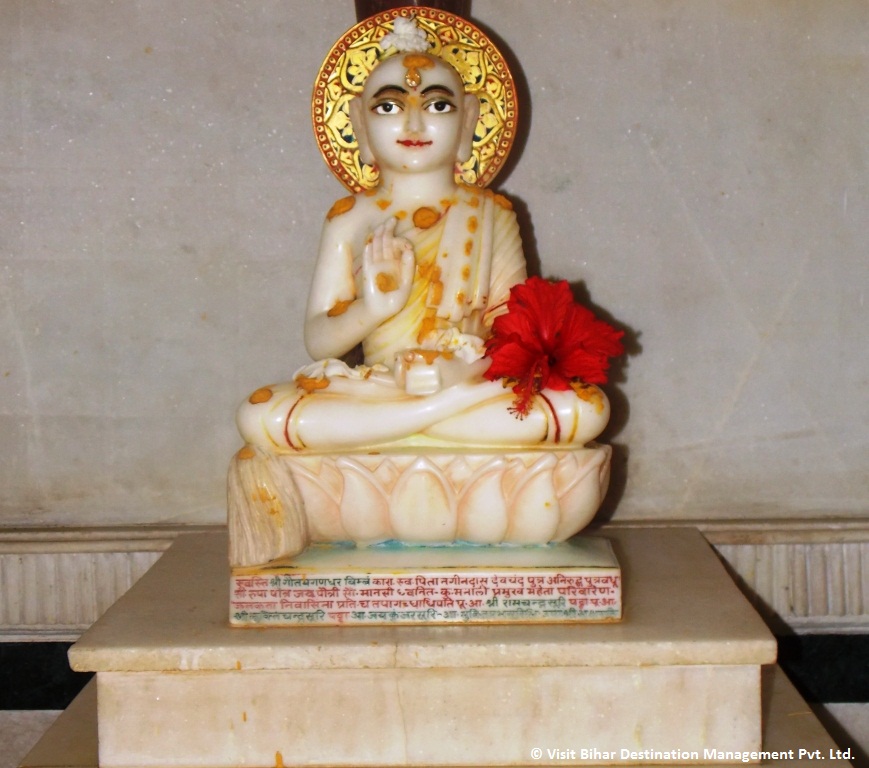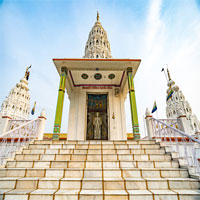Jain Circuit Overview
Jain Circuit Overview
The Cradle of luminous Jain Spiritual souls lies in Bihar. Bihar is the sacred destination as the birthplace of the 12th Tirthankar “Vasupujya” and 24th Tirthankar Mahavira. Their non-violent ascetic path became very popular and become one of the prominent religions of India. According to Jain tradition Vardhaman Mahavira born at the locality called Kundalpur and attained Nirvana at Pawapuri (near Rajgir). In today world a tourist may explore the places associated with the life and preaching of Vardhaman Mahavira and other Jain Tirthankar in Bihar with a rich legacy and with beautiful temples.
We have a set of experience team, who assist you during your spiritual visit of Jain Circuit.
Places associates with Jain Circuit:
The capital of the mighty Magadha Empire in the fourth century BC (also construed as the first recorded Capital in Indian history) is closely associated with the life and teachings of Buddha. Rajgir was the favorite place of Lord Buddha, and became an important centre of Buddhism during the reign of King Bimbisara (543-491 BC) and Ajatashatru (491-459 AD). Lord Buddha delivered many important sermons here. His favorite places in Rajgir were Griddhakuta Hill and Venu Vana. The original road leading to Griddhakuta Hill was built by King Bimbisara to facilitate the Pilgrims visit. Today pilgrims and tourists as everyone loves to see the 160 feet high Vishwa Shanti Stupa (World Peace Pagoda) built on the Ratnagiri hill just behind the Griddhakuta. An aerial ropeway carries the tourists to the hilltop where the Stupa is all alive with the chanting of Buddha. Rajgir is also the place where first Buddhist Council was held in the Saptaparni Caves. The concept of monastic institutions was laid at Rajgir which later developed into magnificent academic and religious centers, producing learned and well disciplined monks. Rajgir is equally sacred to Jains. Lord Mahavira spent 14 rainy seasons in Rajgir and Nalanda between 527-497 BC. He gave his first sermon on Vipula Hill. Each Hill of Rajgir is associated with various Tirthankar. Therefore, there are Jain temples on all the hills of Rajagriha.
There is a natural “Kund” or pond at vipula Hill, which is known as Makhdum Kund, named as it is after Muslim saint Makhdum Saheb, who spent 12 years in jungles of Rajagriha in 13th century AD.
Now a day a tourist of all interest can visit Rajgir to see the religious centers, archaeological site and ecological places.
Nalanda is recorded as the world’s earliest university. Buddha is believed to have visited Nalanda a number of times. His favorite disciple, Sariputra was born here and he died preaching at this place. In third century BC, Mauryan emperor Ashoka honored the famous monk with a grand stupa. Gradually it became associated who gathered here for discourse and by fifth century BC it acquired the position of a well established monastery/University under the Gupta period. During hey days the university was a flourishing residential with over 10,000 students and 1,500 teachers. Hiuen Tsang, the Chinese pilgrim spent three years in Nalanda and left a detailed note about the university and its curriculum, activities and other account. Nalanda today is in ruins but still it imparts the scholarly look. The archeological zone here is classified into a number of sites, so come and experience the look of ancient university.
Vaishali ranked among few of the rare places in history that has left behind a trail of events that reflect the pride of ancient India. It was the capital of the Lichchhavi who was credited with the world’s first republic. Buddha visited Vaishali a number of times and is believed to have delivered several sermons which abound in interesting accounts of the different sojourns of Buddha. Legend has it that on one of his visits, several monkeys dug up a tank for his comfortable stay and offered him a bowl of honey. This is regarded as one of the great incidents in the legends of Buddha, who announced his approaching Nirvana and preached his last sermon here. A life-size lion Pillar beside a brick stupa at Kolhua commemorates Buddha’s last sermon and announcement of his approaching nirvana. The lion faces north, the direction Buddha took on his last voyage. Vaishali also have a archeological museum which house some of the archaeological remains of Buddha and his connection with Vaishali.
24kms from district head quarter of Bettiah are the remains of huge Stupa called Nandangarh. This 26 meter high mound is composed of bricks and is conjectured to be Ashes Stupa, the stupa in which ashes of the Lord Buddha were enshrined. At Lauriya Nandangarh stands the famous pillar of Ashoka – an 8.5 meter single block of polished sandstone bearing an edict of the emperor.
There’s a stupa at Kesaria near Motihari, which is said to be the tallest and the largest Buddhist Stupa in the world. It was discovered in 1998 through excavation by the Archaeological Survey of India. The Stupa’s height is 104 feet, which is far less than its reported original height. Yet, it is one ft taller than the famous Borobodur stupa in Java. Legend has it that Buddha, on his last journey, is reported to have spent a memorable night in Kesaria, where he reportedly made some historical revelations. These were later recorded in Buddhist Jataka Story.
Remains of the ancient Vikramshila University have been excavated at village Antichak in the Bhagalpur district, Bihar. Excavation at this place was done in 1960-61 and has disclosed different periods of habitation. The affairs of the university were entrusted by king Dharampala (10-12 century AD) to one very eminent and taught scholar who was also highly religious. The natural structure exposed and antiquities discovered reiterate that the site was probably the remains of a large monastery and University. A number of Buddha images of stones and terracotta’s have been discovered, some inscribed seals and Stupa have also been found.
To know more about these places, we are offering some readymade tour package along with package with special interest on Buddhism.


